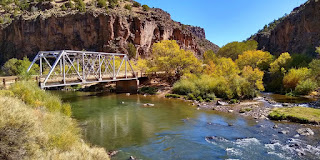 |
| Cliff Shadow 9x12 Oil - Demo, Available |
A mile down below me, a copper-green ribbon of water snakes between pink buttes. Visible but rendered silent by the distance, a ripple of rapids turns the water white. From where I stand, perched on the limestone rim of Grand Canyon, I can obscure the rapids with my little finger, they are so far away. Meanwhile, ravens, coal-black, tumble and play in the vast space. Feeling just the slightest bit of vertigo, I step back.
The Canyon is like that. It'll show you some thing of beauty, and then the next moment remind you how small—and how fragile—you are in the context of its landscape.
My job this past week has been to help students from Arizona, Florida, Maine and Ohio explore that beauty in paint. This was my second time teaching a plein air painting workshop for the Grand Canyon Conservancy Field Institute. As before, it's been a fantastic experience, partly because the GCC works with the National Park Service to make sure I have the access I need to show participants some truly special parts of the park. Also, after years of painting there, I'm eager to share my knowledge of the canyon with my students, as well as to help them wrestle all that vastness down into a small canvas successfully.
Good weather gave us clear skies and warmth after a frosty start each day. A couple of my students camped—camping was free for students—but they stayed warm and cozy in their tents at night, and the sun warmed things up quickly after daybreak. Some wind, which was predicted for mid-week, never really arrived. A painting friend of mine says, "Any day without wind at Grand Canyon is a good day."
Thanks to the weather, we had plenty of time to explore the entire length of the park, from Hermit's Rest in the west to Desert View in the east. This year, I had the honor of playing bus driver and drove the 15-person van. One afternoon, on the return trip from Hermit's Rest, a herd of elk moseyed across the road—a harem of cows plus a bull elk with a large rack—forcing me to stop, which gave everyone a little time to take some photos.
There's plenty more I could write about the week, but pictures do the job so much better. Below are a few. And next week, I'm off to Sedona, Arizona, to teach my next all-level plein air painting workshop. I have a space or two left, so let me know if you're interested.
 |
| Massive 9x12 Oil - Demo, Available |
 |
| Twisted Tree 9x12 Oil - Demo, Available |
 |
| Clinging Tree 9x12 Pastel - Demo, Available |
 |
| A student from Maine, perched near the edge. A ranger told me he likes to stay "two body-lengths" away. There's actually a ledge just beyond him. |
 |
| A student from Florida who paid attention to my lecture and used a ViewCatcher to analyze the scene. It was warm enough for short sleeves! |
 |
| Raku's first glimpse of Grand Canyon. Raku and Trina also camped. |
 |
| Mule riders heading down for Phantom Ranch. Some year, it'd be fun to hike down again and paint there. I'd have the mule riders take my gear. It's only $70 for a 30-pound duffel bag. |
 |
| Sunrise from the Rim Trail on the Hermit's Rest road. |
 |
| My "Clinging Tree" demo, partway done. Near the Desert View Watch Tower. |
 |
| Sometimes, students clustered together, making my job of going from student to student easier. |
 |
| It's always nice to have a picnic table to work on. This is at Hermit's Rest. |
 |
| My "Twisted Tree" demo |
 |
| Me, working on "Cliff Shadows" |
 |
| Sunny spots prevailed. |
 |
| "Cliff Shadows" demo in situ, near the Yavapai Geology Museum |



































